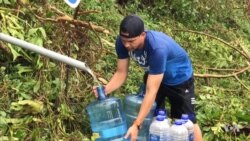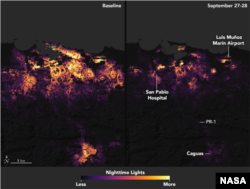More than half of the U.S. territory of Puerto Rico is still without power, more than seven weeks after Hurricane Maria, a Category 4 storm, devastated the Caribbean island. The continuing lack of basic human needs is driving hundreds of thousands of Puerto Ricans to leave, with most of them coming to the southern U.S. state of Florida.
Almost two months since Hurricane Maria struck Puerto Rico in late September, life is still challenging for most people on the island .
Whole neighborhoods are still underwater and more than half the island is still without power.
Everything from gasoline to fresh water is in short supply.
The situation on the ground has pushed hundreds of thousands of Puerto Ricans, who are all U.S. citizens and able to travel freely, to leave for the U.S. mainland, mainly Florida.
"Because of the hurricane we lost our home and right now the children aren't getting an education because many schools are either closed or being used as shelters. So we decided to head to the U.S. mainland," said Christian Vega, a Puerto Rico resident.
The Vegas may be the lucky ones. They have the money, and the support to allow them to leave.
"We work for a company that gave us a transfer and we are going there with work. Both of us. But it is more for our children's education, [and] medicine," he said.
Thousands of others have bought their way off the island on board cruise ships, like Janet and Oliver Ramirez.
But even though their life may be easier on the mainland, leaving home has been difficult.
"You know, things happen. You were born, raised, given values at your house. Your whole mind is set where you live. But, you can't, you don't know what to do," said Manuel Joseph Ramirez, a Puerto Rico evacuee.
Despite the hardships, those who remain are uniting behind the "I'm not giving up movement."
The governor of Puerto Rico has released a study estimating the island has sustained $94 billion worth of damage from the September 20 hurricane.












